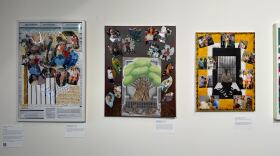One image of a Black laborer in a lumber yard from 1940. A group photo from a unity event between Japanese-American soldiers and white soldiers at Fort Lewis taken two months before the Pearl Harbor attacks. These are some of the images surfaced by a new digital archive project in Tacoma.
The Richards Collection, which is housed in the Tacoma Public Library, has more than 500,000 items in it from a commercial photography studio that was active in Tacoma from 1921-1980.
There are all sorts of images from product photos to community events. But it had very few identifiable images of communities of color, said Andrew Weymouth, the archivist and researcher behind the digitization project.
“There were literally more Caucasians dressed as Native Americans than there were Native Americans in the collection,” Weymouth said, "which is mind blowing to me considering that the Puyallup Reservation was a stone's throw away the entire time.”
Weymouth’s work highlights images of Black, Native and Asian people from early 20th-century Tacoma, increasing their representation in the archive.

The collection had unconventional formats like oversized panorama film prints and Kodachrome Stereo Transparencies, which, Weymouth writes on the project website “were used only briefly in the mid-1950s to document weddings and public events.”
Many portraits, wedding pictures, yearbook photos and commercial images at the time often looked the same with little unique identifying information. Those images tend to have less context and background information in the photo that are useful to researchers and users.
But Weymouth found many of the wedding photos were of Japanese Americans.
“With those photos in particular, I think it's a really unique insight into a culture after World War II, after incarceration, and still resilient and joyful and independent.”

Those stories from Tacoma's historical communities of color were often actively suppressed or simply left out of many archives. And that's led to collections full of gaps.
Filling those gaps is an ongoing project for the Tacoma Public Library’s Northwest Room, which focuses on maintaining and documenting local history in the region.
“We're thinking about people researching their family history 50 years from now, a hundred years from now,” said Northwest Room historian Anna Trammell. Trammell is directing an effort to capture stories from people in the region who've traditionally been excluded.
“We're aware that the silences exist. What can we do right now to make sure that they don't persist moving forward?”
In honor of Black History Month, the library gave out starter kits that have worksheets people can use to start writing down their own family histories. It's not uncommon for Black people to run into dead ends when they try to research their own family histories. So, the library also provided one-on-one help from genealogists with particular expertise in researching Black families that people could talk to if they wanted to trace their roots.
The slate of programming is part of a new community archive center which Trammell said will allow people to contribute to and access a database of local archival material. That database is expected to launch in the spring.
“We're not just devoted to preserving materials related to political figures in Tacoma or some of the big organizations or big topics in our history,” Trammell said. “We want to make sure that we are thinking broadly about what is the story of Tacoma and whose voice has been missing from telling that story.”
Weymouth's work increased representation of Black, Native and Asian communities in the Richards Collection by 60%.
He said some photos had labels describing the cultural group in the picture, but other determinations were judgment calls by the research team.
“You don't know this person's background, but if you don't track this information, then communities who might want to see themselves reflected in some way, they don't have that context through the metadata,” he said.

Weymouth found pictures of everyday life from that era particularly important to the digitization project.
“Things that are not in the light of struggle and racism,” he said. “I think that helps people form a more accurate picture of what life was like in that community.”
And those types of images provide useful context to anyone who might be looking at photos for their own research or for fun.
Photos like the Daffodil parades in the 1950s, which were full of Tacoma’s characteristic contrasts.
“It's that clash of ingenuity and creativity and eye-popping color. And then that very characteristic Tacoma skyline with smokestacks and a little bit of smog in the background,” Weymouth said. “It felt like it was very representative of the time, and it drove home what I really like about Tacoma.”







